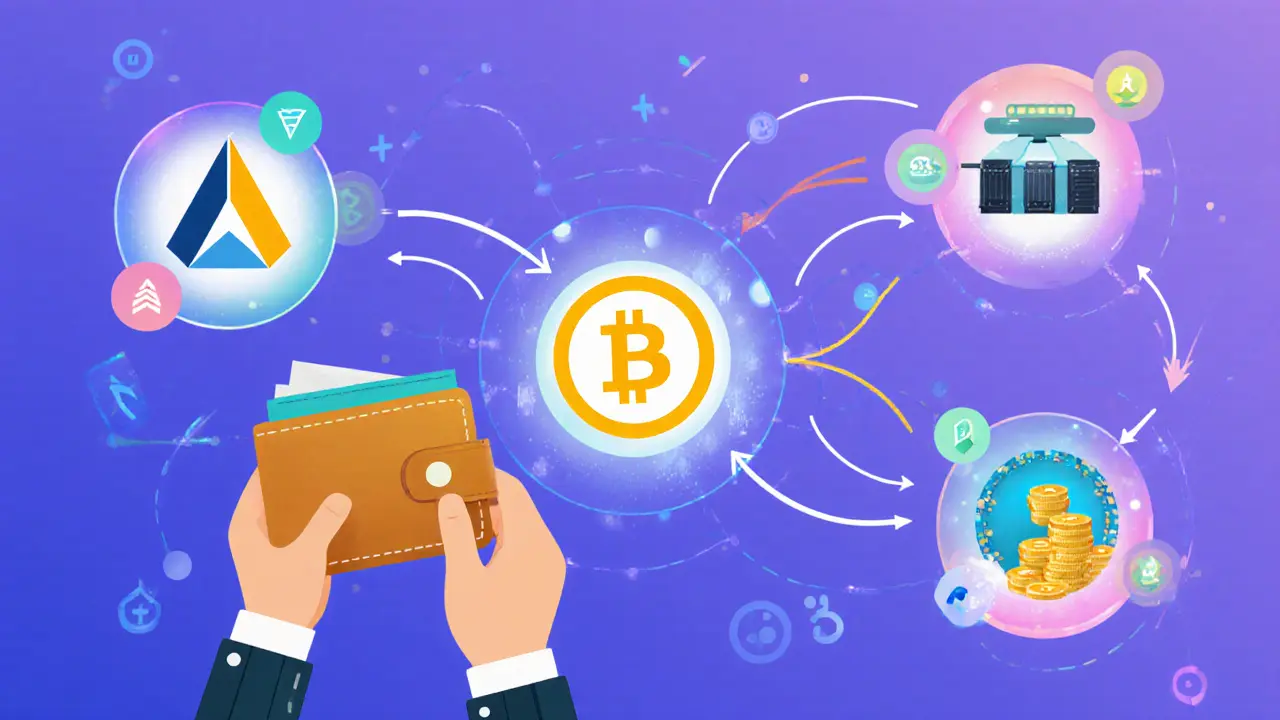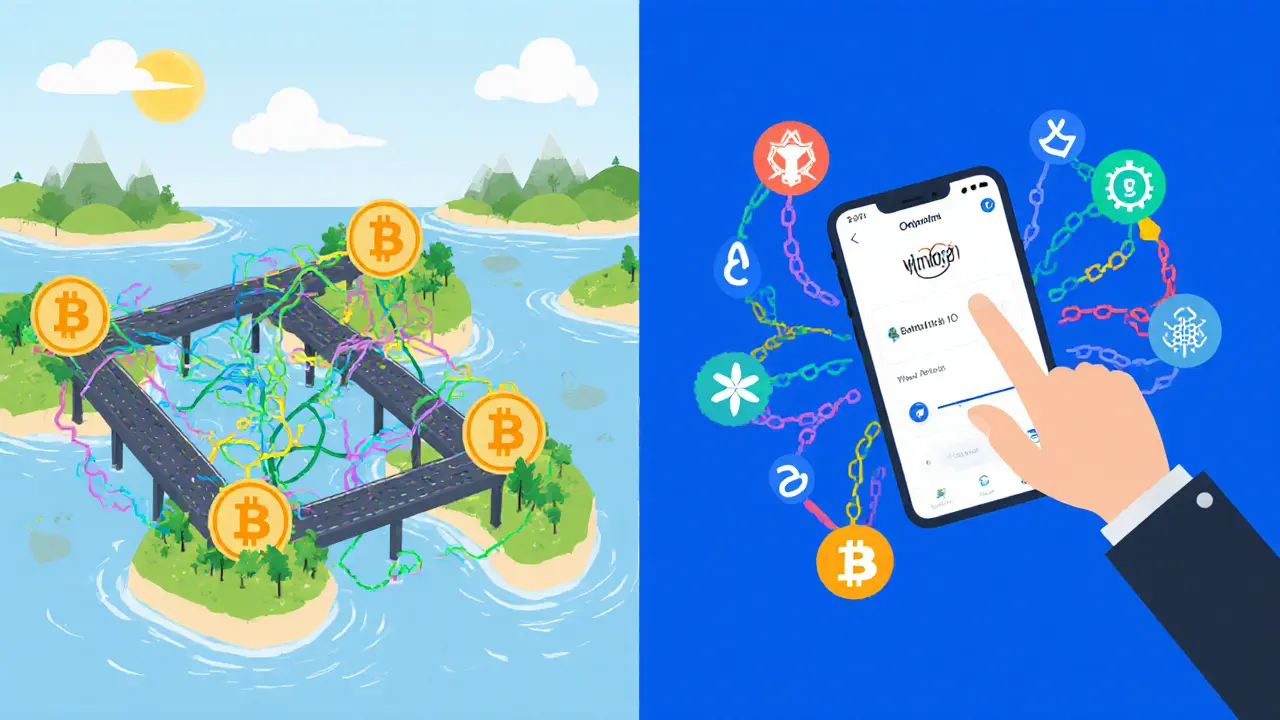What is Radiant Capital (RDNT) Crypto Coin? A Simple Guide to the Omnichain DeFi Lending Token
 Aug, 24 2025
Aug, 24 2025
Cross-chain Lending Calculator
Your Cross-chain Lending Estimate
RDNT RewardsDeposit
$0.00
Source Chain:
Borrowing Options
$0.00
Target Chain:
Potential Rewards
0 RDNT
Estimated Monthly
How it works
Radiant Capital allows you to deposit assets on one chain and borrow on another. Your collateral remains on the source chain while your borrowed assets are available on the target chain. You earn RDNT tokens for both lending and borrowing activities.
Most crypto coins are tied to one blockchain. But Radiant Capital (RDNT) is built to break those walls. If you’ve ever tried to move ETH from Ethereum to Arbitrum, only to get stuck in bridge delays, high fees, or slippage, you know how broken DeFi can feel. Radiant Capital fixes that. It lets you deposit an asset on one chain and borrow another on a completely different chain-all in one click. No bridges. No wrapped tokens. No guesswork.
What Exactly Is Radiant Capital?
Radiant Capital is a DeFi lending protocol that works across multiple blockchains. It’s not just another Aave or Compound clone. While those platforms lock your money into one chain-like Ethereum-Radiant lets you use your USDC on BNB Chain to borrow ETH on Arbitrum. The magic happens because it’s built on LayerZero, a cross-chain messaging protocol that connects blockchains without relying on third-party bridges.
The native token, RDNT, is the engine behind it all. Holders can vote on protocol changes, earn rewards by locking their tokens, and even get a cut of the interest paid by borrowers. It’s not just a coin-it’s the governance and incentive layer of a whole new lending system.
How RDNT Works: Lend, Borrow, Earn Across Chains
Here’s how it actually works in practice:
- You connect your wallet (MetaMask, WalletConnect, etc.) to the Radiant app.
- You deposit, say, USDC on BNB Chain.
- You immediately see you can borrow ETH, wstETH, or even rETH on Arbitrum.
- You borrow $5,000 worth of ETH, using your USDC as collateral.
- Later, you repay the loan and withdraw your USDC-still on BNB Chain.
That’s it. No swapping, no bridging, no waiting 20 minutes for a transaction to confirm across chains. Radiant handles the movement behind the scenes using LayerZero and Stargate’s stablecoin router. The whole process feels like using a single app on one network-even though you’re jumping between five different blockchains.
And here’s the kicker: you earn RDNT tokens for doing this. Lenders get RDNT for depositing assets. Borrowers get RDNT for taking out loans. Even people who add liquidity to RDNT/WETH pools earn rewards. This isn’t just a yield farm-it’s a self-sustaining economy.
Tokenomics: Supply, Distribution, and Incentives
Radiant launched with a total supply of 1.5 billion RDNT tokens. As of late 2023, about 1.31 billion are in circulation, with over 350,000 unique wallets holding them. That’s a lot of adoption for a project that only went live in 2022.
The token distribution breaks down like this:
- 40% to users (lenders, borrowers, liquidity providers)
- 20% to the Radiant DAO treasury
- 15% to early backers and investors (including Binance Labs and Arbitrum Foundation)
- 10% to team and advisors (vested over 3 years)
- 15% to ecosystem growth and partnerships
What makes RDNT different from other DeFi tokens is how rewards are structured. Instead of dumping tokens on the market and hoping people stick around, Radiant ties rewards to locking. If you lock your RDNT for 12 months, you get a bigger share of the protocol’s revenue. This keeps the token supply tight and gives long-term holders real skin in the game.

Why RDNT Stands Out: Omnichain vs. Single-Chain DeFi
Most DeFi protocols are like isolated islands. Aave runs on Ethereum. Compound runs on Ethereum. dYdX runs on Starknet. If you want to move money between them, you need a bridge-and bridges are slow, expensive, and sometimes hacked.
Radiant Capital doesn’t just connect chains-it removes the need to move at all. Your assets stay where they are. You just access liquidity from everywhere else. This is why it’s called an omnichain protocol.
Compare that to competitors:
| Feature | Radiant Capital (RDNT) | Aave | Compound | Stargate Finance |
|---|---|---|---|---|
| Chains Supported | 8+ (Ethereum, Arbitrum, BNB Chain, Polygon, etc.) | 1 (Ethereum) | 1 (Ethereum) | 6+ (cross-chain swap, not lending) |
| True Cross-Chain Lending | Yes | No | No | No (swap-only) |
| Native Governance Token | RDNT | Aave | COMP | STG |
| TVL (Late 2023) | $120M | $1.2B | $650M | $180M |
| Asset Selection | 8 core assets (USDC, ETH, wstETH, etc.) | 30+ assets | 20+ assets | 10+ assets |
Radiant doesn’t beat Aave on size. But it beats it on flexibility. If you’re someone who hops between chains, or you want to earn yield on assets without moving them, Radiant is the only game in town.
Real User Experiences: Pros and Cons
People who use Radiant consistently mention two things: the cross-chain experience feels seamless, and the interface is surprisingly simple.
On Reddit, users in r/DeFi praised the ability to “loop” ETH-depositing ETH on Arbitrum, borrowing USDC, then converting that USDC back to ETH on BNB Chain-all without paying bridge fees. Some reported earning 0% APR on this strategy, effectively borrowing for free while keeping exposure to ETH.
But it’s not perfect. Common complaints include:
- Slippage on cross-chain deposits-sometimes you get less than expected.
- Limited asset options compared to Aave or Compound.
- Gas fees vary wildly depending on which chain you’re using.
- Learning curve for new users-understanding collateral ratios and liquidation risks isn’t easy.
One user on CryptoSlate said: “I tried it because I was tired of bridging. It worked. But I still check my positions twice-just to be sure.” That’s the trade-off: convenience comes with responsibility.
Security and Team: Is Radiant Safe?
Radiant has been audited by Blocksec, a top-tier blockchain security firm known for catching economic exploits. The protocol also uses a risk management system that adjusts collateral requirements dynamically based on market volatility.
The team behind Radiant includes veterans from both traditional finance and crypto. Several core contributors worked at Binance and ConsenSys before launching Radiant DAO. The project is fully decentralized, with no central CEO or company behind it-just a DAO that votes on upgrades.
That’s a good sign. No centralized team means no single point of failure. But it also means updates move slowly. If you want a quick feature fix, you’ll need to wait for a community vote.

Price Predictions and Long-Term Outlook
As of November 2025, RDNT trades around $0.011. That’s up from $0.003 in early 2023. The market cap sits at roughly $16 million-tiny compared to Aave’s $1.2 billion.
Some analysts predict RDNT could hit $0.15 by 2030. Others go further, suggesting $18 by 2050. These are speculative. But they’re based on one real idea: if cross-chain DeFi becomes the norm, Radiant could be one of the few protocols ready for it.
Right now, most users still stick to Ethereum because it’s familiar. But as more chains gain traction-Arbitrum, Base, zkSync, Polygon-the demand for cross-chain lending will grow. Radiant is already built for that future.
Who Should Use Radiant Capital?
Radiant isn’t for everyone. If you’re new to crypto and just want to earn 5% on your USDC, stick with Coinbase or BlockFi.
But if you:
- Use multiple chains regularly
- Want to avoid bridge fees and delays
- Understand DeFi basics like collateral ratios
- Believe cross-chain is the future of DeFi
…then RDNT is worth exploring. You’re not just investing in a token-you’re betting on a better way to lend and borrow in crypto.
How to Get Started with RDNT
Here’s a quick step-by-step:
- Get a Web3 wallet (MetaMask or WalletConnect).
- Fund it with ETH (for gas) and an asset like USDC or ETH.
- Go to radiant.capital and connect your wallet.
- Select a chain to deposit from (e.g., BNB Chain).
- Choose an asset to borrow on another chain (e.g., ETH on Arbitrum).
- Confirm the transaction and start earning RDNT.
Pro tip: Join the Radiant Discord. There’s a user-made guide called “Chain Selection Guide” that’s been viewed over 15,000 times. It cuts the learning curve in half.
Is RDNT a good investment?
RDNT isn’t a traditional investment like Bitcoin. It’s a utility token tied to a protocol that’s still growing. If cross-chain DeFi takes off, RDNT could gain value as usage increases. But if adoption stalls, it could stay flat or decline. Only invest what you’re comfortable losing.
Can I stake RDNT?
You can’t stake RDNT like ETH. But you can lock it to earn a larger share of protocol revenue. Locking for 12 months gives you more rewards than holding freely. This is called “veRDNT” (voting-escrowed RDNT), and it’s how governance and incentives are aligned.
Where can I buy RDNT?
RDNT is available on major decentralized exchanges like Uniswap, PancakeSwap, and SushiSwap. It’s also listed on centralized exchanges including KuCoin, Gate.io, and Bitget. Always check the contract address before buying-there are fake tokens.
What’s the difference between RDNT and other DeFi tokens like AAVE or COMP?
AAVE and COMP are limited to Ethereum. RDNT works across chains. That’s the big difference. RDNT also rewards both lenders and borrowers, while most other tokens only reward depositors. And RDNT’s rewards are tied to locking, not just holding.
Is Radiant Capital audited?
Yes. Radiant has been audited by Blocksec, a reputable security firm. The protocol also has a risk management system that adjusts collateral requirements based on market conditions. No major exploits have occurred since launch.
Rajesh pattnaik
November 24, 2025 AT 01:02Radiant is kinda wild man, i tried it last week on my phone while chilling in Delhi. Deposited USDC on BNB Chain and borrowed ETH on Arbitrum in like 45 seconds. No bridge, no waiting, no panic. Felt like magic. Now i just keep RDNT locked for 12 months and let it earn me while i sleep. No stress, just vibes.
Belle Bormann
November 24, 2025 AT 05:59omg i just used radiant for the first time and it worked?? i thought i was gonna lose my usdc. i deposited on polygon and borrowed wsteth on arbitrum and it just… happened. no idea how but i got rdnt for it. thanks for the guide, this is the first time a defi thing didnt make me want to cry.
Jennifer MacLeod
November 25, 2025 AT 07:00Okay but let’s be real - this is the future. Why are we still bridging? Why are we still stuck on one chain like it’s 2020? Radiant doesn’t just make life easier, it removes the friction entirely. You’re not moving assets, you’re accessing liquidity like a god. And the fact that borrowers get RDNT too? That’s genius. Most protocols just reward depositors and leave borrowers out in the cold. This is how you build a real ecosystem, not just another yield farm that dies in six months.